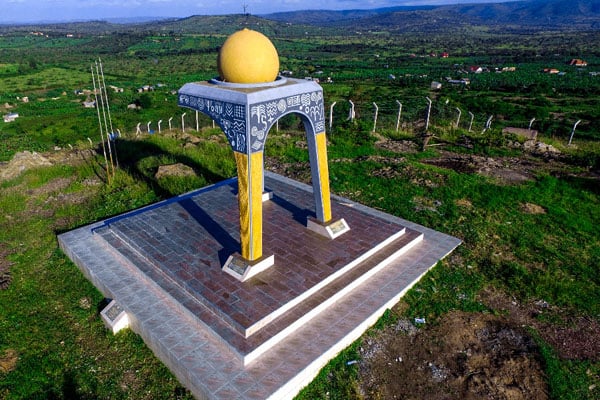Prime
Why Ankole’s tourism sites remain untapped

An aerial view of the The Biharwe Eclipse Monument in Mbarara District. PHOTOs | COURTESY
What you need to know:
- Leaders say some of the tourist sites have not been well publicised.
Ankole Sub-region is endowed with several tourist attractions but many remain untapped, the Daily Monitor has established.
These include the Mugabe Palace, the headquarters of the defunct Ankole Kingdom at Kamukuzi Hill; Lake Mburo, and Queen Elizabeth national parks, and the crater lakes of Rubirizi.
The sub-region is also famous for its long-horned cattle, a special breed of African cattle.
Ankole region consists of 12 districts including Mbarara, Rwampara, Kazo, Kiruhura, Ibanda, Ntungamo, Sheema, Buhweju, Bushenyi, Mitooma, and Rubirizi.
The region is one of the major coffee-growing areas. Coffee is mostly grown in the Bushenyi and Buhweju districts. The region also boasts of the beautiful scenery.
Mr Howard Muhwezi, a youth leader in Mbarara City, says despite tourism being one of the biggest contributors to the economy, there is no deliberate effort to popularise the region’s sites to the outside world.
“There are no deliberate plans to market our tourism sites. They think tourism is all about wild animals and yet there is cultural tourism and others. Local communities need to be empowered to promote all aspects of tourism,” he says.
Mr Devin Itaagi, the chief executive officer of Canine Safaris, a tour company operating in western Uganda, says the local governments do not appreciate tourism as an important driver of social-economic transformation.
“Most of the sites in the region are not profiled. If they were profiled, you would know that from Kampala to Kasese, several attractions will interest your visitors. But you can’t find these,” he said.
Mr Itaagi also accuses local administrators of doing little to collaborate with other partners to promote tourism.
“Local governments need to promote partnerships and collaborations with stakeholders in the tourism sector like tour operators and the Uganda Tourism Board to penetrate the tourism sector market and earn from it,” he says.
He adds: “The tourism sector should be digitalised to make it accessible to tourists by a mere tap of the computer button. Tourist attractions, plans, and visits are all over the world digitalised.”
Mr Rogers Mugarura, the Rwampara District tourism officer, says the tourist sites in the region are not well publicised.
“We have a host of tourist attractions that remain unknown to the outside world mainly because of lack of marketing. The problem is compounded by lack of funding in the district budget, so as an officer responsible for this sector, I have nowhere to start from,” he said.
The poor road network also hampers tourists from visiting the sites.
“The biggest part of the district is hilly, making it hard for tourists to access some of the sites,” Mr Mugarura says.
He adds that currently, the district does not earn from the sites since they are privately owned.
Mr Robert Aturinda, the Ntungamo District tourism officer, says the central government has focused on promoting nature and habitat tourism neglecting other potentials like culture and religious tourism.
“Some of the tourism potentials in this country have not been given priority. The only focus has been on nature and habitat tourism while culture and religious tourism is a big potential if developed,” he says.
Mr Bonny Tashobya, the Mbarara City speaker, says they are soon introducing a clear plan to generate revenue from the available tourist attractions in the city.
“We are coming up with a policy that will allow us to start collecting revenue from these attractions. Visitors should not come and enjoy our treasures for free and once they start paying, we will have resources to upgrade these tourism sites and work on roads and other amenities in these areas,” he says.
Mr Kweyamba Ruhemba, the chief administrative officer of Ibanda District, says they will come up with a comprehensive plan to develop the available sites in the district.
“We have plenty of tourist sites but we have not been earning from them directly,” he says.
Mr Edward Kasagara, the chief administrative officer of Rubirizi District, says most districts in the region have not aligned their tourism potential to the national web.
“Most tourists who come here know where they are going through government agencies like the Uganda Tourism Board, so they connect directly to these places but along the way, they have stopovers, for example when they are going to Queen Elizabeth National Park, they have stopovers in Mbarara, Ishaka but the tourism potentials in these stopovers have not been marketed on the national web, so they remain unknown,” he said.
He says Rubirizi has been able to earn much from tourism because they have identified it as a niche for revenue enhancement.
“We have done a lot of marketing and sensitisation of the local communities on how tourism can transform them. That is why along our roads you find a lot of tourist attractions like art and crafts, honey, fruits by locals targeting tourists, numerous hotels and tourism sites and they pay a tax to us. Our responsibility is now to see that we extend the necessary infrastructure to facilitate the growth of this sector,” he says.
The spokesperson for the Ministry of Tourism, Wildlife, and Antiquities, Ms Eunice Kansiime, advised local governments to invest in publicising these sites.
“Most of the sites in the region are as rewarding as other sites, the local governments should publicize and market them. It is not the responsibility of the ministry to publicise these sites,” she says.
Compiled by Rajab Mukombozi, Perez Rumanzi, Julius Byamukama, Coslin Nakayiira, Jovita Kyarisiima & Felix Ainebyoona




